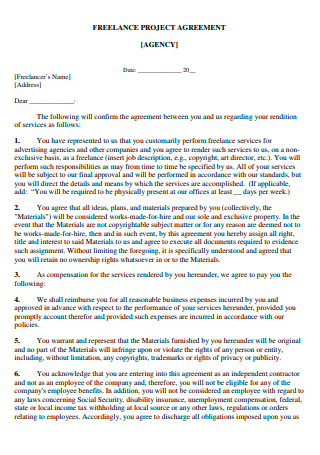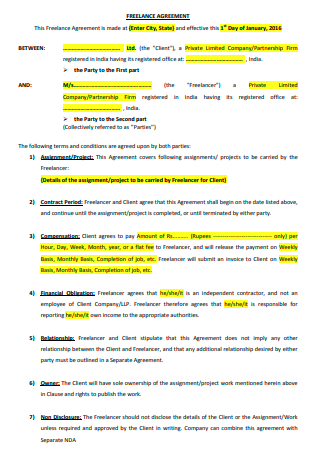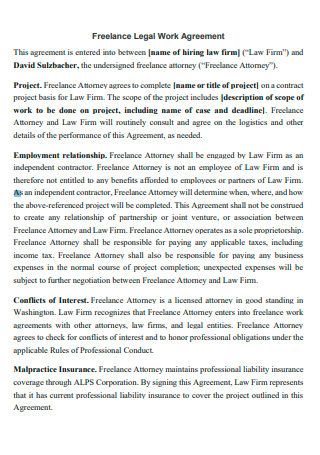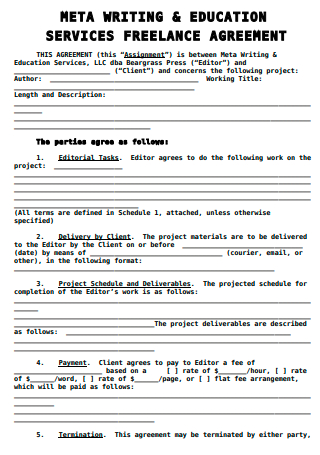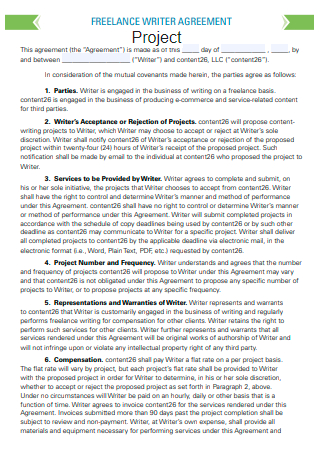4+ Sample Freelance Project Agreement
FREE Freelance Project Agreement s to Download
4+ Sample Freelance Project Agreement
What Is a Freelance Project Agreement?
What Is the Importance of Freelance Project Agreement?
How to Get Your First Freelancing Client or Project:
Steps on How to Write a Freelance Project Agreement:
FAQs
When should you drop a freelance client?
What employment rights do freelancers have?
Do freelancers pay income tax?
What Is a Freelance Project Agreement?
A Freelance Project Agreement is a legal contract between two parties and are the best way to protect yourself as a freelancer. This type of a written document lays out the details of the relationship with the client and what is expected from both parties—to ensure freelancers get paid for their work on time and in full. They also remove any potential for either party to back out of their agreement, or at the very least penalize them if they do.
Additionally, Freelance Project Agreements can be difficult, and many longstanding freelancers will just prepare their contract templates to use for most jobs, however, there is a reason they are also very important to get right.
Just to start with the basics, freelancers need the contract to outline exactly what is expected of them and in what timeframe. This is to make sure their client does not suddenly turn around asking for more work and refusing to cough up extra cash because the contract has some vague wording. The best tip is to get as particular as one possibly can and to also specify how much back-and-forth a freelancer is prepared to do per project.
What Is the Importance of Freelance Project Agreement?
Agreements are used throughout people’s lives for different exchanges—from renting a house to enrolling on a course. Business is always a two-way affair, and an agreement warrants that your needs as a freelancer and their needs as a client are valued.
Most freelancers, especially those that have newly made the jump, often overlook the importance of having some kind of contract with their clients. When scoping out a project with a new client, it is great to get fired up about the work and want to jump in head-first. Eagerness is key to not just winning but keeping clients.
While paperwork is what you want to do least when you became your own boss, a customized contract for each client is a requirement. Indeed, this approach is often seen as a minimum that many freelance veterans advise drafting a contract for each project. Here is a list of the importance of having an agreement:
How to Get Your First Freelancing Client or Project:
There are five tips suggested to help you get your first gig and establish a freelancing career. Here they are:
1. Identify Your Skills
The skills section of a resumé simply lists down your knowledge in terms of technologies and techniques. However, you have to identify what you can do with each of those skills in the real world.
Make it clear so that the client understands what you can do for them.
Your skills could be:
- Web development
- Digital marketing
- Data Analysis
- Graphic design
Your services could be:
- Building high-performance end-to-end websites and web applications.
- Helping individuals and SMEs in promoting their products and services online.
- Creating beautiful illustrations and digital artworks for websites, videos, and posters.
- Crunching data to uncover patterns and answer important business-centric questions to make informed decisions.
2. Define Your Ideal Client or Market
There is no freelancing career without clients, but that doesn’t mean you should reach out or pitch your services to just anyone. This won’t do you much good, and instead will add to your frustration. Since you have your niche from the first step, now do some research on who needs that kind of service.
3. Build Your Portfolio And Profiles
It is time to set up your shop after determining your niche and your target clients. In this case, it can be your portfolio website or profiles on platforms like LinkedIn, Upwork, Toptal, or AngelList.
Portfolio website
An essential thing to note here is that you want someone to trust you with their business. So, you can start by telling your professional story. Portfolio websites are one way to do just that. If you do not have a story to tell yet, create one by working for yourself. You can build sample websites using commonly used themes available online, or you can propose to work on a project for a prospective client for free.
Profiles
You should be socially present on professional platforms aside from having a website. This will help you look for and connect with prospective clients—it can give you work ideas; it lets you post updates, and helps you promote yourself.
A good profile can increase your chances of getting an opportunity for different reasons:
- It can display your work samples and proficiency in skills to offer a service in your niche.
- It shows how seriously you take your work.
- It can add to your credibility if you have testimonials or recommendations written by an authentic colleague/partner/ex-boss.
4. Pitch to Clients
Time to get down to business. If you can sell your services and show that you are well-suited to the clients’ requirements and budget; you might get the opportunity. But first, you need to get clients to propose to. This is where you need to work on your visibility and outreach.
5. Capture The Data, Analyze Them, And Attune Your Process
You might land your first project in a day, in a month, or in 6-months. In any way, an integral part of the process is to keep exploring and improving. You might fail at your first attempt but use that failure to get better at it.
Capture the data:
- Why your proposal got rejected. Request a comment from the client.
- The number of projects/clients you reached out to. How many responded, got interested, rejected, or went ahead.
- What’s new in your niche? How are people operating?
- People who are successful in your niche, what are they doing differently?
Analyze the data:
- Understand each data point you have captured, funnel the type of clients whom you had more chances to convert.
- The gap between the requirements of the project and your portfolio?—?see what’s missing.
- Create a separate category of clients for whom you have to bridge a gap between their requirements and your expertise.
Attune your process:
- Re-write the proposal emphasizing their needs and your services along with your work samples and numbers/statistics.
- Start working on new projects to attain new skills or master the ones you have enlisted.
- If you are spending 2 hours a day on creating proposals and pitching to clients, then spend at least 3–4 hours on polishing your skill. Your strategy will only work if you have that curiosity to learn and build every day.
- Restructure, polish and attune your profile to the client’s needs.
Steps on How to Write a Freelance Project Agreement:
The best way to put it is that a contract is a legally binding agreement created between two parties. It comes after the initial proposal has been shared with the freelancer or is at a point where they are sending invoices over. There are the steps that make-up a freelance agreement:
-
Step 1: Names, Contact Information, And Dates
The full names of both parties should appear at the beginning, and also throughout, any contract. Being precise prevents probable mix-ups with other people and companies. Moreover, the full contact information like physical address, email address, phone number and more should be included for each party as well. Finally, make it certain that your contract is dated both when you write it, and when it is signed by each party.
-
Step 2: Your Role
The proposal should give all the information you need in your contact here. You may start with the deliverables: it is what will drive your work but will also be reviewed first if anything goes wrong. It is also what should trigger the payments you will receive. Next, follow with your responsibilities: List all of the obligations required to complete the work that’s mentioned in the proposal, and nothing more. This way, if the client tries to get you to do something that’s out of your agreement, you can decline politely.
-
Step 3: Payment Information
Start by defining how you expect to be paid since getting paid by the hour may make you a little more money, but unless you use some sort of online tracking system to log your hours, the client will probably prefer that you get paid by the job. In that case, it is standard to receive a portion of the payment ahead and the rest when a job is done. Whichever method you use to get paid; you need to put it in writing so that there are no misunderstandings about it later on.
-
Step 4: Deadlines
Another disadvantage to being a freelancer is that it can be hard to focus since it is easy to get distracted. Without deadlines, freelancers will often lose focus and push projects further back, while clients get anxious as they wait longer for work to be turned in. This is not a healthy relationship. Breaking up a project into various milestone achievements, rather than having it all due at once, is generally the smart way to go. This way, the freelancer is less likely put themselves in a situation where they have a huge amount of work due in an impossibly short amount of time. And procrastination aside, milestones just make it easier to keep everything systematized, which should be a welcome benefit for both parties.
-
Step 5: Ownership
In most cases, clients are going to need the contract to grant them full rights to your works since the client is the one paying you to do the work. This is just the way these things work. However, sometimes you might be able to be credited for your work, even if you don’t own the rights to it. Credited works look great in your portfolio—but you should confirm with the client that they don’t have a problem with you placing work you did for them in your portfolio, before you go around parading it as one of your personal creations.
-
Step 6: Confidential information
You might come across confidential information like customer lists, business strategies, website stats while working on a project. The client will want the contract to include a clause that prohibit you from disclosing any of that confidential information.
-
Step 7: Independent Contractor Terms
There should be different expectations for your work as an independent contractor. A few of those differences:
- You don’t represent the client.
- They don’t represent you.
- The client won’t expect to provide you with the physical tools you need to complete a project.
- You won’t expect the client to manage your day-to-day schedule.
- And you will be liable for your own taxes, too.
-
Step 8: Termination terms
Eventually, every project comes to an end. Unless you are signing up for longstanding, ongoing work, it will probably make sense for you to set a final date by which, if all the work is not done yet, you will stop working and the client will pay you for all the work that has been completed so far.
FAQs
When should you drop a freelance client?
If one client project is taking a lot of time, dropping them and finding a more suitable client might be the best option. This can speed up the workflow and improve the cash flow swiftly.
What employment rights do freelancers have?
Unfortunately, you are not entitled to the basic employment rights that all employees enjoy if you are self-employed. These include maternity leave, minimum pay, sick pay, annual leave, working time rights, the right to join a union, health and safety protection and protection from discrimination. You will also need to make your own pension arrangements.
Do freelancers pay income tax?
According to the income tax laws, freelancers are also liable to pay taxes for the income they earn just like other salaried or business taxpayers.
Freelancing is a good career choice for many professionals; however, it depends on your goals, financial situation, and risk tolerance. It is also a very good long-term career choice if you are willing to put in more work upfront for more upsides in the future. Just one big advantage to freelancing is the freedom and flexibility. You can just wear what you want, wake up when you want, set your schedule, and more.
Additionally, freelancing offers the possibility of great independence. Key benefits include setting their own hours and choosing where and how they work. One very pleasing aspect of freelancing is a lack of meetings and a lack of administrative issues. Lastly, freelancers have the freedom to reject projects or clients that they do not like.

